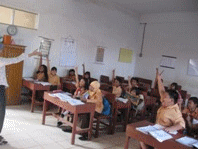Posted in Uncategorized | 7 Comments »
The advances of technology have created opportunity in improving mathematics education. The aims of using technology are: (1) how teachers can use technological tools to replace or complement traditional media; (2) how students may benefit from learning with technology; and (3) how technology interacts with other elements of instruction.
1. INTRODUCTION
ICT (Information and Communication Technology) is the digital equipment which can store, process, and communicate the information. The omnipresent ICT has been a special interest topic in educational institute, because ICT could replace the aids tools, textbooks and chalkboards, for the teacher.
In Singapore the education authorities encourages the use of computer to upgrade teaching and learning by conveying computer hardware and software as infrastructure , and training teachers in first stage of the information technology (IT) master plan (MP1) from 1997 to 2002. It aims that every student would have access to technology in learning (Ministry of Education, 1997). In the second stage of the master plan(MP2), the aim is to rule the ICT in bringing together key areas of education such as curriculum, assessment, instruction, and professional development to build school environments that are conducive for engaged and holistic learning (Ministry of Education, 2002).
Posted in Resume of Papers and The Book's Chapters | Leave a Comment »
c. Wawancara (Interview)
Wawancara adalah suatu metode atau cara yang digunakan untuk mendapatkan jawaban dari respondent dengan jalan tanya jawab sepihak, secara lisan, berhadapan muka dengan arah serta tujuan yang telah ditentukan (Djaali, 2008).
Wawancara pada dasarnya dapat dilakukan denga dua cara yaitu interview bebas dan interview terpimpin.
Posted in Resume of Papers and The Book's Chapters | Leave a Comment »
Pengertian Non tes
Teknik penilaian non tes berarti tehnik penilaian dengan tidak menggunakan tes. Tehnik penilaian ini umumnya untuk menilai kepribadian anak secara menyeluruh meliputi sikap, tingkah laku, sifat, sikap sosial, ucapan, riwayat hidup dan lain-lain. Yang berhubungan dengan kegiatan belajar dalam pendidikan, baik secara individu maupun secara kelompok. Alat penilaian non-test, yang biasanya menyertai atau inheren dalam pelaksanaan proses belajar mengajar sangat banyak macamnya. Di antaranya bisa disebutkan adalah angket (kuesioner), observasi, wawancara, sosiometri, checklist, concept map, portfolio, student journal, pertanyaan-pertanyaan, dan sebagainya. Keberhasilan siswa dalam proses belajar-mengajar tidak dapat diukur dengan alat tes. Sebab masih banyak aspek-aspek kemampuan siswa yang sulit diukur secara kuantitatif dan mencakup objektifitas misalnya aspek efektif psikomotor.
Posted in Resume of Papers and The Book's Chapters | Leave a Comment »
Langkah-langkah Penyusunan Alat Penilaian Teknik Tes
Dalam mengembangkan atau menyusun sebuah tes hasil belajar supaya tes tersebut memiliki karakteristik tes yang baik, harus ditempuh sejumlah langkah-langkah sebagai berikut:
- Menetapkan tujuan penilaian atau tujuan tes
Setiap orang yang mau melakukan kegiatan penilaian, harus sadar apa tujuan dia melakukan penilaian tersebut. Artinya keputusan apa yang akan dia ambil dari dari hasil penilaian tersebut. Secara umum tujuan kegiatan evaluasi atau keputusan yang dapat di ambil oleh guru di sekolah dapat dikelompokkan kedalam tes formatif, tes sumatif, tes diagnostik, tes penempatan atau seleksi. Untuk jenis-jenis tes ini telah dijelaskan pada uraian sebelumnya.
- Menganalisis dokumen-dokumen
Setelah seorang guru menetapkan tujuan apa yang ingin dicapai dengan melakukan penilaian tersebut adalah menelaah dokumen-dokemen. Dokumen yang di maksud adalah:
Posted in Resume of Papers and The Book's Chapters | Leave a Comment »
Pengertian
Dalam Djaali (2008) disebutkan bahwa secara umum tes diartikan sebagai alat yang digunakan untuk mengukur pengetahuan atau penguasaan obyek ukur terhadap seperangkat konten dan materi tertentu. Menurut Sudiyono (1996) dalam Djaali (2008), tes adalah alat atau prosedur yang digunakan dalam rangka pengukuran dan penilaian.
Tes dapat juga diartikan sebagai alat pengukur yang mempunyai standar objektif, sehingga dapat dipergunakan secara meluas, serta betul-betul dapat digunakan untuk mengukur dan membandingkan keadaan pskis atau tingkah laku individu. Tes merupakan suatu prosedur yang sistematis untuk mengamati atau mendeskripsikan satu atau lebih karakteristik seseorang dangan menggunakan standar numeric atau system kategori.
Posted in Resume of Papers and The Book's Chapters | Leave a Comment »
The Uniqueness of Experimental Research
- Experimental research is unique in that it is the only type of research that directly attempts to influence a particular variable, and it is the only type that, when used properly, can really test hypotheses about cause-and-effect relationships. Experimental designs are some of the strongest available for educational researchers to use in determining cause and effect.
Essential Characteristics of Experimental Research
- Experiments differ from other types of research in two basic ways ― comparison of treatments and the direct manipulation of one or more independent variables by the researcher. Continue Reading »
Posted in Resume of Papers and The Book's Chapters | Leave a Comment »
The Nature of Qualitative Research
- The term qualitative research refers to the quality of relationships, activities, situations, or materials.
- The natural setting is a direct source of data, and the researcher is a key part of the instrumentation process in qualitative research.
- Qualitative data are collected mainly in the form of words or pictures and seldom involve numbers. Content analysis is a primary method of data analysis.
- Qualitative researchers are especially interested in how things occur and particularly in the perspectives of the subjects of a study.
- Qualitative researchers do not, usually, formulate a hypothesis beforehand and then seek to test it. Rather, they allow hypotheses to emerge as a study develops.
- Qualitative and quantitative research differ in the philosophic assumptions that underlie the two approaches. Continue Reading »
Posted in Resume of Papers and The Book's Chapters | Leave a Comment »
Journal Review
Title: The Effects of Writing in a Secondary Applied Mathematics Class: A Collaborative Action Research Project (2007)
Researcher (Author): Louis Lim and David K. Pugalee
Reviewer: Rully Charitas Indra Prahmana
Introduction
An action research study was conducted in a grade 10 applied mathematics class to examine the National Council of Teachers of Mathematics’ (2000) posit that students “communicate to learn mathematics and they learn to communicate mathematically” (p. 60). The project grew out of communication and collaboration between a high school teacher in greater Toronto and a university professor from the southeastern United States whose research focus is in language and mathematics. Continue Reading »
Posted in Resume of Papers and The Book's Chapters | Leave a Comment »
The Importance of Studying Relationships
- We believe that understanding is generally enhanced by the demonstration of relationships or connections.
- Understanding of relationships helps us to explain the nature of the world in which we live.
Variables
- A variable is any characteristic or quality that varies among the members of a particular group.
- A constant is any characteristic or quality that is the same for all members of a particular group.
- Several kinds of variables are studied in educational research, the most common being independent and dependent variables. Continue Reading »
Posted in Resume of Papers and The Book's Chapters | Leave a Comment »








